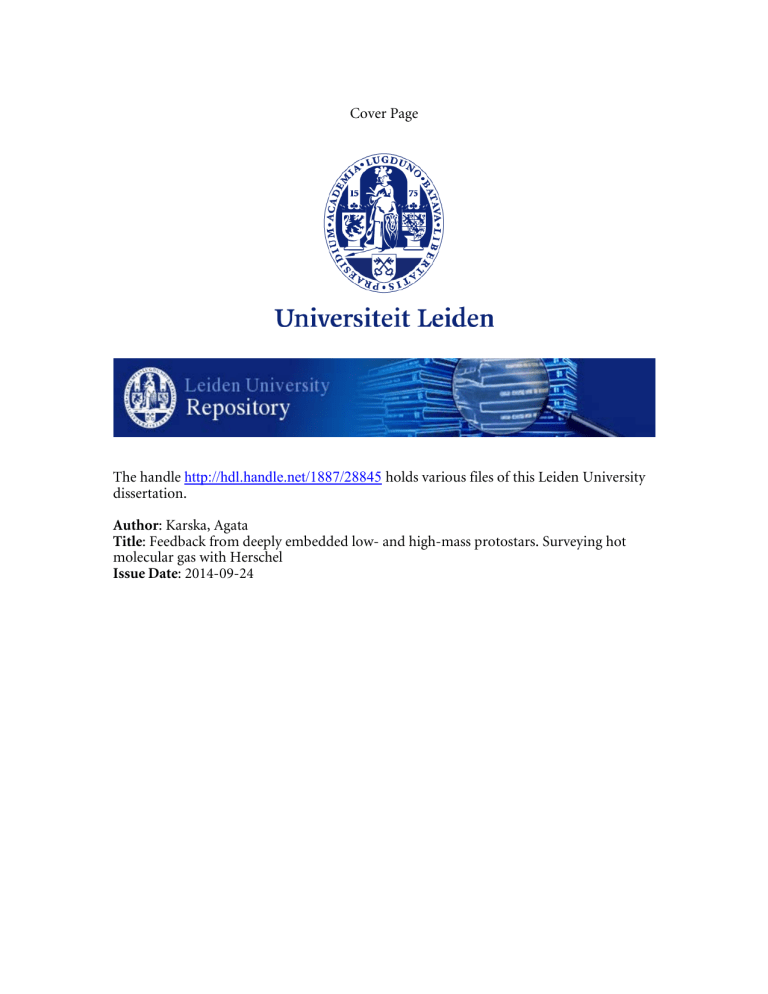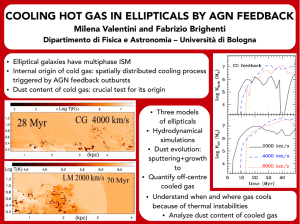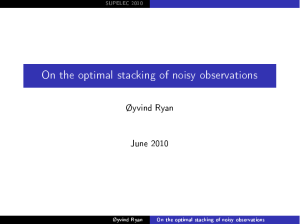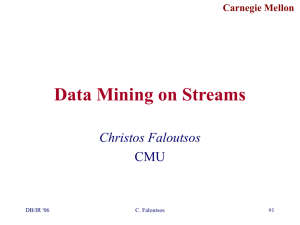Title Pages_Contents - Universiteit Leiden

Cover Page
The handle http://hdl.handle.net/1887/28845 holds various files of this Leiden University dissertation.
Author: Karska, Agata
Title: Feedback from deeply embedded low- and high-mass protostars. Surveying hot molecular gas with Herschel
Issue Date: 2014-09-24
Feedback from deeply embedded low- and high-mass protostars
Surveying hot molecular gas with Herschel
Feedback from deeply embedded low- and high-mass protostars
Surveying hot molecular gas with Herschel
PROEFSCHRIFT ter verkrijging van de graad van Doctor aan de Universiteit Leiden, op gezag van de Rector Magnificus prof. mr. C. J. J. M. Stolker, volgens besluit van het College voor Promoties te verdedigen op woensdag 24 september 2014 klokke 11.15 uur door
Agata Karska geboren te Inowrocław, Polen op 8 juni 1985
Promotiecommissie
Promotor: Prof. dr. E. F. van Dishoeck Leiden University,
Max-Planck-Institut für extraterrestrische Physik
Co-Promotor: Dr. G. J. Herczeg Kavli Institute, Beijing
Overige leden: Prof. dr. A. G. G. M. Tielens Leiden University
Prof. dr. H. J. A. Röttgering Leiden University
Prof. dr. P. Caselli
Prof. dr. N. J. Evans II
Dr. B. Nisini
Dr. E. Sturm
Max-Planck-Institut für extraterrestrische Physik
University of Texas
Istituto Nazionale di Astrofisica (INAF), Rome
Max-Planck-Institut für extraterrestrische Physik
Dedicated to the entire PACS team
Cover: Artist’s view of low-mass star forming regions.
Feedback from deeply-embedded low- and high-mass protostars.
Surveying hot molecular gas with Herschel.
Copyright © 2014 Agata Karska
Thesis Universiteit Leiden - Illustrated – With summary in Dutch and Polish – With references
ISBN 978-94-6259-279-7
Printed by Ipskamp Drukkers ipskampdrukkers.nl
Cover by Arte Buena / Monika Aleksandrowicz artebuena.eu
9 789462 592797
“Ignorancja nasza jest oceanem ogólno´swiatowym, za´s wiedza pewna
– pojedynczymi wysepkami na tym oceanie”
– Stanisław Lem
[Our ignorance is like the world’s ocean, while our limited knowledge
– like individual islands on this ocean]
Contents
1 Introduction 1
1.1
Interstellar medium and sites of star formation . . . . . . . . . . . . . . .
3
1.2
Evolution before the main sequence . . . . . . . . . . . . . . . . . . . .
4
1.2.1
From dense cores to stars and planets . . . . . . . . . . . . . . .
4
1.2.2
Observational classification of young stellar objects . . . . . . . .
5
1.3
Heating and cooling in deeply-embedded protostars . . . . . . . . . . . .
7
1.3.1
Processes leading to gas heating . . . . . . . . . . . . . . . . . .
7
1.3.2
Main cooling channels . . . . . . . . . . . . . . . . . . . . . . .
12
1.4
Herschel / PACS . . . . . . . . . . . . . . . . . . . . . . . . . . . . . .
15
1.4.1
PACS spectrometer . . . . . . . . . . . . . . . . . . . . . . . . .
16
1.4.2
Comparisons to ISO / LWS . . . . . . . . . . . . . . . . . . . . .
18
1.4.3
WISH, DIGIT, and WILL programs . . . . . . . . . . . . . . . .
18
1.5
This thesis . . . . . . . . . . . . . . . . . . . . . . . . . . . . . . . . . .
19
2 Water in star forming regions with Herschel (WISH) III. Far-infrared cooling lines in low-mass young stellar objects 25
2.1
Introduction . . . . . . . . . . . . . . . . . . . . . . . . . . . . . . . . .
27
2.2
Observations . . . . . . . . . . . . . . . . . . . . . . . . . . . . . . . .
29
2.2.1
Sample selection . . . . . . . . . . . . . . . . . . . . . . . . . .
29
2.2.2
Observing strategy . . . . . . . . . . . . . . . . . . . . . . . . .
29
2.2.3
Reduction methods . . . . . . . . . . . . . . . . . . . . . . . . .
33
2.2.4
Spectral energy distributions . . . . . . . . . . . . . . . . . . . .
34
2.3
Results . . . . . . . . . . . . . . . . . . . . . . . . . . . . . . . . . . . .
34
2.3.1
Emission spectra . . . . . . . . . . . . . . . . . . . . . . . . . .
34
2.3.2
Spatial extent of line emission . . . . . . . . . . . . . . . . . . .
36
2.3.3
Velocity shifts in [O i
] and OH lines . . . . . . . . . . . . . . . .
40
2.4
Analysis . . . . . . . . . . . . . . . . . . . . . . . . . . . . . . . . . . .
40
2.4.1
Rotational diagrams . . . . . . . . . . . . . . . . . . . . . . . .
40
2.4.2
Far-infrared line cooling . . . . . . . . . . . . . . . . . . . . . .
44
2.4.3
Flux correlations . . . . . . . . . . . . . . . . . . . . . . . . . .
47
2.5
Origin of far-IR line emission . . . . . . . . . . . . . . . . . . . . . . . .
51
2.5.1
Spatial extent of line emission and correlations . . . . . . . . . .
53
2.5.2
Excitation . . . . . . . . . . . . . . . . . . . . . . . . . . . . . .
54
2.5.3
Comparison with shock models . . . . . . . . . . . . . . . . . .
57
2.5.4
Evolution from Class 0 to Class I . . . . . . . . . . . . . . . . .
58
2.6
Conclusions . . . . . . . . . . . . . . . . . . . . . . . . . . . . . . . . .
61 ix
Appendices 63
2.A Targeted lines and measurements . . . . . . . . . . . . . . . . . . . . . .
63
2.B Extended source correction method . . . . . . . . . . . . . . . . . . . . .
67
2.C Spectral energy distributions . . . . . . . . . . . . . . . . . . . . . . . .
68
2.D Spatial extent of line emission . . . . . . . . . . . . . . . . . . . . . . .
71
2.E
Comparing PACS and ISO far-IR spectra . . . . . . . . . . . . . . . . . .
71
2.F
Rotational diagrams . . . . . . . . . . . . . . . . . . . . . . . . . . . . .
71
2.G Correlations . . . . . . . . . . . . . . . . . . . . . . . . . . . . . . . . .
72
2.H Rotational temperature uncertainties . . . . . . . . . . . . . . . . . . . .
72
2.I
Cooling budget calculations . . . . . . . . . . . . . . . . . . . . . . . .
72
3 Far-infrared molecular lines from low- to high-mass star forming regions observed with Herschel 85
3.1
Introduction . . . . . . . . . . . . . . . . . . . . . . . . . . . . . . . . .
87
3.2
Observations and data reduction . . . . . . . . . . . . . . . . . . . . . .
89
3.3
Results . . . . . . . . . . . . . . . . . . . . . . . . . . . . . . . . . . . .
91
3.4
Analysis . . . . . . . . . . . . . . . . . . . . . . . . . . . . . . . . . . .
93
3.4.1
Far-IR line cooling . . . . . . . . . . . . . . . . . . . . . . . . .
93
3.4.2
Molecular excitation . . . . . . . . . . . . . . . . . . . . . . . .
99
3.5
Discussion: from low to high mass . . . . . . . . . . . . . . . . . . . . . 107
3.5.1
Origin of CO emission . . . . . . . . . . . . . . . . . . . . . . . 107
3.5.2
Molecular excitation . . . . . . . . . . . . . . . . . . . . . . . . 110
3.5.3
Correlations . . . . . . . . . . . . . . . . . . . . . . . . . . . . . 113
3.5.4
Far-IR line cooling . . . . . . . . . . . . . . . . . . . . . . . . . 113
3.6
Conclusions . . . . . . . . . . . . . . . . . . . . . . . . . . . . . . . . . 116
Appendices 119
3.A Details of PACS observations . . . . . . . . . . . . . . . . . . . . . . . . 119
3.B Continuum measurements . . . . . . . . . . . . . . . . . . . . . . . . . 121
3.C Tables with fluxes and additional figures . . . . . . . . . . . . . . . . . . 123
3.D OH in low and intermediate mass sources . . . . . . . . . . . . . . . . . 125
4 Shockingly low water abundances in Herschel / PACS observations of lowmass protostars in Perseus 133
4.1
Introduction . . . . . . . . . . . . . . . . . . . . . . . . . . . . . . . . . 135
4.2
Observations . . . . . . . . . . . . . . . . . . . . . . . . . . . . . . . . 137
4.3
Results . . . . . . . . . . . . . . . . . . . . . . . . . . . . . . . . . . . . 139
4.3.1
Spatial extent of line emission . . . . . . . . . . . . . . . . . . . 139
4.3.2
Line detections . . . . . . . . . . . . . . . . . . . . . . . . . . . 142
4.3.3
Observed line ratios . . . . . . . . . . . . . . . . . . . . . . . . 144
4.4
Analysis . . . . . . . . . . . . . . . . . . . . . . . . . . . . . . . . . . . 147
4.4.1
Model line emission . . . . . . . . . . . . . . . . . . . . . . . . 147
4.4.2
Models versus observations – line ratios of the same species . . . 152
4.4.3
Models and observations - line ratios of di ff erent species . . . . . 155 x
4.5
Discussion . . . . . . . . . . . . . . . . . . . . . . . . . . . . . . . . . . 158
4.5.1
Shock parameters and physical conditions . . . . . . . . . . . . . 158
4.5.2
Abundances and need for UV radiation . . . . . . . . . . . . . . 161
4.6
Conclusions . . . . . . . . . . . . . . . . . . . . . . . . . . . . . . . . . 164
Appendices 167
4.A Supplementary material . . . . . . . . . . . . . . . . . . . . . . . . . . . 167
4.B Correlations with source parameters . . . . . . . . . . . . . . . . . . . . 175
5 Physics of deeply-embedded low-mass protostars: evolution of shocks, ultraviolet radiation, and mass flux rates 177
5.1
Introduction . . . . . . . . . . . . . . . . . . . . . . . . . . . . . . . . . 179
5.2
Observations . . . . . . . . . . . . . . . . . . . . . . . . . . . . . . . . 181
5.2.1
Sample selection . . . . . . . . . . . . . . . . . . . . . . . . . . 181
5.2.2
Observations and data reduction . . . . . . . . . . . . . . . . . . 186
5.3
Results . . . . . . . . . . . . . . . . . . . . . . . . . . . . . . . . . . . . 187
5.3.1
Detection statistics . . . . . . . . . . . . . . . . . . . . . . . . . 187
5.3.2
Cross-species line flux correlations . . . . . . . . . . . . . . . . 188
5.4
Analysis . . . . . . . . . . . . . . . . . . . . . . . . . . . . . . . . . . . 190
5.4.1
CO excitation . . . . . . . . . . . . . . . . . . . . . . . . . . . . 190
5.4.2
Molecular and atomic cooling . . . . . . . . . . . . . . . . . . . 194
5.4.3
Mass flux rates in jets and outflows . . . . . . . . . . . . . . . . 196
5.4.4
Comparisons to models of shocks and photodissociation regions . 198
5.5
Discussion . . . . . . . . . . . . . . . . . . . . . . . . . . . . . . . . . . 201
5.5.1
Origin of CO emission: a two-shock scenario . . . . . . . . . . . 201
5.5.2
Origin of [O I] emission: disk, jet, or UV-heated cavity walls? . . 202
5.5.3
Mass flux rates: evidence for jet evolution? . . . . . . . . . . . . 204
5.6
Summary and conclusions . . . . . . . . . . . . . . . . . . . . . . . . . 205
Appendices 207
5.A Correlations of fluxes and flux ratios . . . . . . . . . . . . . . . . . . . . 207
5.B Correlations with sources parameters . . . . . . . . . . . . . . . . . . . . 208
5.C Rotational diagrams for the WILL sources . . . . . . . . . . . . . . . . . 209
Nederlandse samenvatting
Streszczenie w j ˛ezyku polskim
Bibliography
Publications
Curriculum vitae
Acknowledgments
215
221
227
235
239
241 xi


